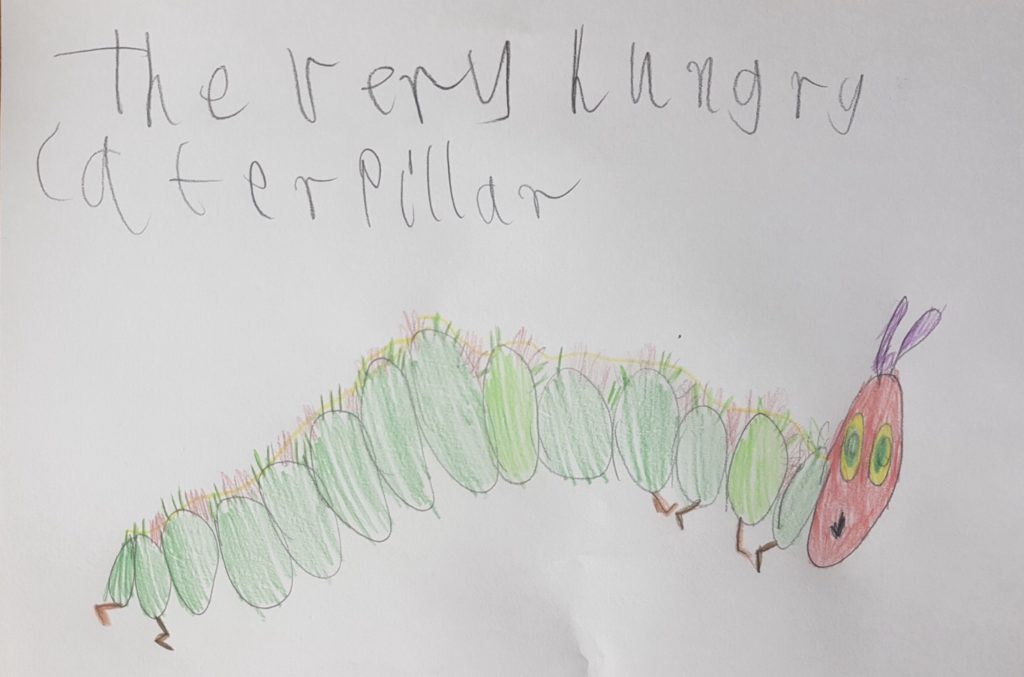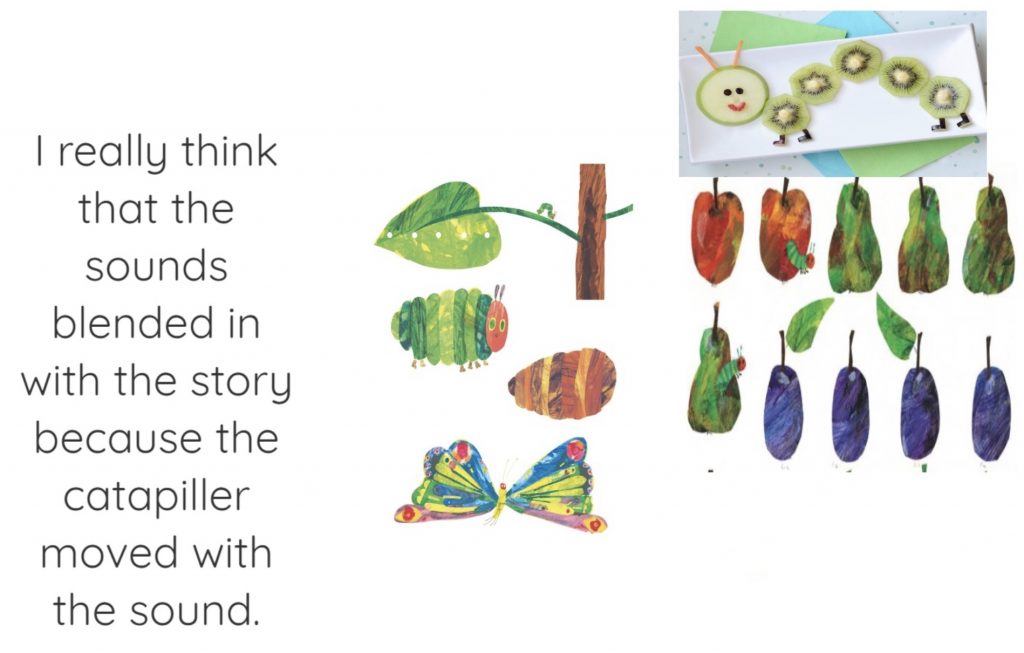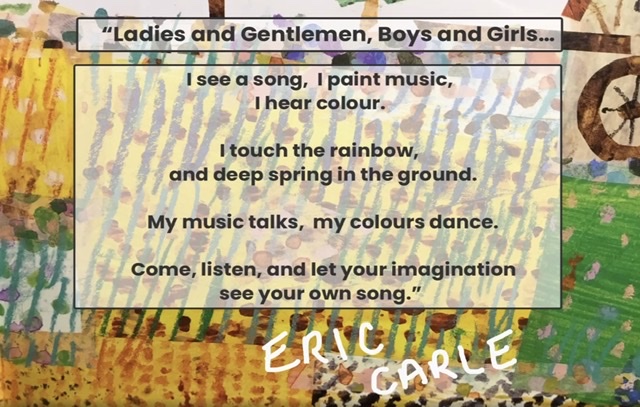‘The Very Hungry Caterpillar’: Story, Colour, Shape and Music. ‘I See a Song’.

Yr 1 Elspeth’s drawing. 
Yr 2 Ada’s response.
Welcome to Term 4 everyone, I hope you had an enjoyable Spring break. In many ways, my eyes and ears are still on holidays as we have been delighting in the books of Eric Carle through animation. This was a wonderful way to get the students thinking about what makes up a soundtrack to a film or an animation, and how music supports story telling. We found out that there are 4 different sound worlds which combined to make the sound track of our much loved story ‘The Very Hungry Caterpillar’ when it was animated in 1993, and it wasn’t a big nudge to get curious about how the sounds for the chomping, tummy rumbling and snoring caterpillar were made… enter from stage left the Art of Foley! Also, we listened to the music written especially for Eric Carle’s book ‘I See a Song’. Before watching the animation, we focused on what what we think about and feel when we close our eyes and listen to music, and we shared the ‘story telling’ of our imaginations.
It’s been an absolute joy to learn more about Eric Carle, and to share with the students interview footage of him talking about his life and explaining why he loves to make books for children. Actually, Eric Carle said that he doesn’t create books for children, he makes them for every child, because every child learns differently. In addition to feeling inspired by watching him in his studio, painting gorgeous coloured tissue papers for his collage designs, many students commented about what stood out for them in relation to Eric Carle’s first collaboration with the author Bill Martin Jr. ‘Brown Bear, Brown Bear, What do You See?’ was the first book Eric Carle ever illustrated. There was a deep resonance between Bill and Eric as they had both found learning at school a very difficult journey. Bill was 20 years old when a teacher he met observed that he could not yet read. The teacher helped him to learn through rhythm and rhyme, and suddenly for Bill, literacy began to ‘click’. So, when Bill writes a book for children, the first thing he thinks of is, ‘What is the rhythm for this story?’, then he adds the words. How fantastic!
The students were bowled over that so much learning was occurring when they were enjoying ‘The Very Hungry Caterpillar’ as young preschoolers. They were reciting the days of the week, counting, colours, the life cycle of a butterfly, and on top of it all here was a story of hope: you might start out as a caterpillar, but you can become a colourful butterfly and fly! It was a very happy ‘trip down memory lane’ but with wider eyes and deeper resonances, after all, everyone at PHPS has had the Eric Carle experience of making glorious, superb collage art with Hannah and Sarah Rowe, our Visual Artist in Residence during the Wellbeing Festival in Term 4 last year. I was thrilled that students made this connection and also commented about the art they are now working on with Laura. All this formed the ‘back story’ for our actual focus in this activity which was the sound track to ‘The Very Hungry Caterpillar’ animation!
‘The music helped me recognise the story more easily.’ Alice from Yr 1
‘The music is much more effective for supporting a story when it’s especially written for that story, rather than choosing music ‘off the shelf’.’ Nico Yr 5/6
Arabella in Yr3 commented about the rich colours of the animation and how they relate to the sounds of colour in the orchestral music: wonderful! We learnt that the music for ‘The Very Hungry Caterpillar’ was especially composed by the film score composer Julian Nott. I mentioned his name because students would be familiar with other music he has written, including the theme music for ‘Thomas the Tank Engine’ and ‘Wallace and Gromit’. Students noticed how musical themes followed the repetitive format of the Hungry Caterpillar story, and that these themes had their own instrumental colours: for example, a rising french horn theme sounded when the moon was in the sky, along with owls and cicadas, and the flutes had a higher, more lyrical melody when the sun came up… with lots of twittering birds too. Bingo.. the students had identified two sound areas, the music and sounds of nature. There were also lots of added sound effects which lent a comedic quality to the caterpillar’s character as Jimmy in yr 5/6 pointed out. The fourth sound was not commented on often as perhaps we take it for granted, but the sound of the narrator’s voice, and the style of their story telling is a very important consideration for the animation director.
The students were amazed at the amount of work which goes into creating an animation sound track, so we explored further and had a dip into the art of Foley Artists. This was a lot of fun, and an eye opener for them!
This week, we stayed in the world of Eric Carle and focused on how his art inspired the music Julian Nott wrote for Eric Carle’s story ‘I See a Song’. At the beginning of the story, Eric Carle writes these words:

Before we watched the animation of this story I asked the students to listen to the orchestral music as a piece of music in its own right, and to be aware of what the music inspires in their imaginations and how the music made them feel.
‘The music made me feel so happy. I feel like a flower.’ Matilda Prep.
‘Songs. Colour. I was a rainbow. Well that’s what I felt like.’ Miles Yr 1.
‘The music reminds me of getting in the zone with my violin’ Aurelie Yr 5/6
There were references to places, people and experiences of hearing orchestral music: flying on a plane listening to music, visiting grand parents, going to the fair, being in a fancy tea-room, going to the rodeo, walking down the street in the olden days and living in a castle. Happy, calm and relaxed were words that were expressed in many responses.
The joy continued when students reflected about hearing the same music with Eric Carle’s animated illustrations.
‘Eric Carle said, “Colour speaks, you feel colour”. I got very emotional watching the animation. The music and the instruments add feeling to the art. I love it.’ Sammy Yr4.
‘Nina was bounding like a happy puppy when she saw the animation’ Nina Prep
‘The animation felt like it connected to the words at the start and held the purpose of the video there with that saying’ Reuben Yr 5/6
‘I related the colour and shapes to the art we are doing with Laura. Laura was talking about synesthesia, seeing colour when listening.’ Aurelie Yr 5/6
It has been a treat to linger in the worlds of art and music with the students. There is so much to talk about and share, and I look forward to returning to school to further explore the many themes which have emerged. Many thanks to everyone for your responses, and families too for supporting your child’s learning. Take care over the coming weeks and Cheerio. Deb
